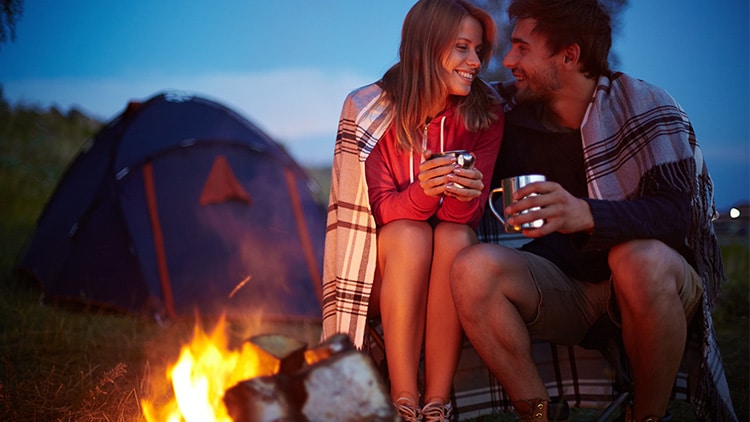Summer Campfire Safety
Wednesday March 13, 2019

Late summer nights just beg for an outdoor fire. Whether you’re renting a cabin in a state park for a weekend getaway with someone special, or just enjoying your own back yard, the smell of woodsmoke and the glint of firelight in the eyes of your loved ones is a pleasure millions of years old. It still brings a deep contentment, even in the digital age.
But…it’s dangerous. Easy to screw up and start a much larger fire than you intended. Especially as the heat of August begins to dry out the air, and the trees and plants ready themselves for autumn.
With a little planning, you can safely enjoy s’mores on your porch with the kids, or a night in the deep woods with someone you love. Just remember a few simple safety tips.
Check the Local Rules
If you’re camping, you’re almost certainly in a park, state, or national forest. And though these spaces are set aside for us to enjoy nature, they’re also carefully managed by trained experts who look after them.
They’ll have established some rules. Chances are pretty good that there’s a sign on the visitor’s center letting you know whether fires are permitted this time of year. If there isn’t, stop in and ask for tips.
Starting a campfire when the rangers have forbidden them isn’t just illegal…it’s stupid. They only post restrictions when they’re needed for everyone’s safety.
Besides, they may tell you the best spot to have and undisturbed evening around the fire. (We should also note that some parks require a fire permit. They’re typically free, or nearly so).
Check the Forecast
The easiest way to lose control of your fire is to build one on a windy night. Even a mild wind can throw burning debris at you…besides, in shifting winds, the smoke will make you miserable.
Look Around, and Even Up
The most important step in setting up a safe, enjoyable campfire is the first one – pick the right spot.
You’ll want a radius of eight to ten feet around the fire where there are no bushes, brush piles or other potential sources of fuel. The only things burnable near your fire should be the ones you bring to it.
This means looking up, too. Low-hanging branches or other obstructions can be dangerous if the fire flares where you don’t expect it to.
Build A Border If There Isn’t One
A metal fire ring or other prepared fire pit is best. But, if you’re starting a campfire in a place that isn’t prepared for one, you’ll need to prepare it. Clear a space around your intended fire, and scoop out a depression in the soil. Ring your pit with rocks that will help keep the fire to contained space.
Be Prepared with Water or Dirt
You may need to quickly put out a flare-up. Don’t wait until your fire grows larger than you planned to figure out how you’re going to deal with that.
Keep water or loose dirt ready to throw on any errant flames.
Keep Your Firewood Short, and Store it Safely
You’ll probably end up wanting smaller pieces of wood than you think. Longer, larger pieces can burn all night, and it’s wasteful to burn them part way and then douse them. Use more, smaller pieces.
If you’re reserving some to throw on later, store it at least five feet from your fire, and upwind.
Never Use Lighter Fluid or Other Accelerants on a Campfire
You might be tempted to get the fire going with lighter fluid or some other fuel. It isn’t worth it. Build your fire slowly from small kindling, and enjoy the process. Adding liquid fuel can lead to serious injuries…and rob you of the joy of exercising a skill older than time.
Stack Wood Strategically
Build a bed of tinder (small twigs, dry leaves, and grass, or if you brought it, paper). Pile kindling (smaller sticks or cut pieces under one-inch thick) in the center in a teepee pattern.
Then place firewood around it in a lattice, or log cabin, pattern, allowing plenty of space for air to flow between the pieces. This makes for a more controllable, predictable fire. It also makes for a fire that’s easier to light.
Keep a Careful Eye on Children and Pets
You know what’s worse than a child with a nasty burn? A child with a nasty burn far from medical care, late at night.
Keep a close eye on kids and pets around the fire.
Make Someone Responsible for the Fire
Some of your group will want to wander away and come back to the fire. Some may want to go hunt through their bags for that book they’re halfway through.
Some will need to sneak off and use the facilities.
If you’re not careful, you can start a lovely fire and stop monitoring it.
So, designate someone as the keeper of the fire. You can take turns, but make sure it’s always someone’s turn.
Extinguish It Before Bed
Never leave a fire burning unattended. Never leave a few coals glowing.
When you’re done with it, put it out.
This can be done with water, or with dirt, but it must be done. Put it out, and stir the coals around to ensure they’re all wet or cold before you leave them.
Then, hold your palm a few inches from the remains of the fire to ensure it’s truly out. If you can still feel the heat, you may need to stir it again.
